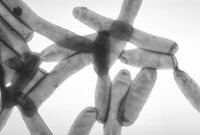Legionella pneumophila
For the course duration, the article is closed to outside editing. Of course you can always leave comments on the discussion page. The anticipated date of course completion is May 21, 2009. One month after that date at the latest, this notice shall be removed. Besides, many other Citizendium articles welcome your collaboration! |
| Legionella pneumophila | ||||||||||||||
|---|---|---|---|---|---|---|---|---|---|---|---|---|---|---|
 | ||||||||||||||
| Scientific classification | ||||||||||||||
| ||||||||||||||
| Binomial name | ||||||||||||||
| Legionella pneumophila |
Description and significance
Legionella pneumophila is a rod shaped, flagellated and a gram negative bacteria. L. pneumophila are aerobic and non-capsulated. It is known to be pathogenic to humans and leads to legionellosis or legionnaires’ disease. The name Legionnaires comes from an outbreak of this disease during a convention of American Legions in 1976. (attach references to … http://www.visualdxhealth.com/atlas/legionellosisLegionnairesDisease.htm)
L. pneumophila is determined to be the dominant human pathogen in its genus of 41 different species . It was first found to be pathogenic in 1976 when a group of men were found to be infected. It spread to more than 200 individuals and led to 34 casualties. It was first isolated by inoculation of a guinea pig with the blood sample of an infected person in 1947.
Genome structure
There are three genomes from the species L. pneumophila that have been studied well. These are Legionella pneumophila str. Paris, Legionella pneumophila str. Lens and Legionella pneumophila ssp. Pneumophila str. Philadelphia 1. All three of these genomes have been completed recently between 2001 and 2004.
| Name | Genes | Base Pairs | Year |
|---|---|---|---|
| Legionella pneumophila str. Paris | 3136 | 3,503,610 | 2004 |
| Legionella pneumophila str. Lens | 3001 | 3,345,687 | 2004 |
| Legionella pneumophila ssp. Pneumophila str. Philadelphia 1 | 3002 | 3,397,754 | 2001 |
Cell structure and metabolism
Ecology
In general L. pneumophila can be found in aquatic environments worldwide. L. pneumophila can be found in many large water systems, such as those used in buildings. It often ends up in the heating and cooling components of residential apartments. If such water systems are left unchecked, it can lead to outbreaks of Legionnaires’’ disease can occur. (reference used…http://www.visualdxhealth.com/atlas/legionellosisLegionnairesDisease.htm)
Pathology
Infection by L. pneumophila in humans is called Legionnaires’ disease or Legionellosis. Once infected there are two possibilities: the person might develop pneumonia, which is the dangerous version of the disease or the person might develop Pontiac fever, which is usually nonfatal. Many cases of Legionnaires’ disease go unnoticed because infections of Legionnaires’ disease are often reported as respiratory infections and in some cases a treatment for respiratory infections can also treat the Legionnaires’ disease. (references attach to …http://www.visualdxhealth.com/atlas/legionellosisLegionnairesDisease.htm) There are 41 different species in the genus Legionella and these are further divided into 64 serogroups. The serogroups 1, 4, and 6 are responsible for most human infections of Legionnaires’ disease. Serogroup 1 is determined to be the cause of 70-90% of such infections. Studies show approximately only 5-15% of Legionnaires’ disease cases are fatal.
A recent case, in January 2009, of Legionnaires’ disease has occurred at a recently opened luxurious hotel in Dubai. Three individuals who had been residing at Westin Dubai Mina Seyahi Beach Resort reported severe illness after leaving the hotel. Furthermore one of the three individual, who was a famous Cricket Broadcaster in Britain, passed away after battling the disease for a short period. The other two individual continue to struggle with Legionnaires’’ disease. The hotel authorities have cooperated and allowed the testing for Legionella bacteria in the hotel; so far all results have returned negatively. (attach reference to article…http://www.hotelchatter.com/tag/Hotel%20Sick)
| Year | Male | Female | Total |
|---|---|---|---|
| 1999 | 42 | 14 | 56 |
| 2000 | 125 | 29 | 154 |
| 2001 | 78 | 8 | 86 |
| 2002 | 139 | 29 | 167 |
| 2003 | 127 | 20 | 147 |
| 2004 | 151 | 9 | 160 |
| 2005 | 252 | 29 | 281 |
| 2006 | 452 | 66 | 518 |
| 2007 | 527 | 141 | 668 |
| 2008 | 529 | 157 | 686 |
Application to Biotechnology
Current Research
sub categories